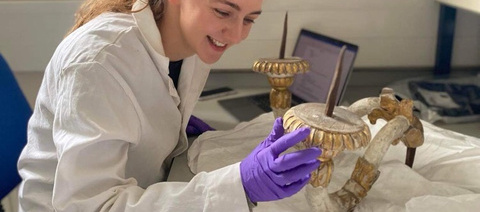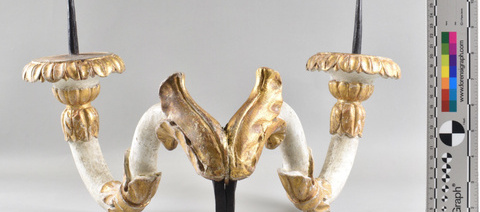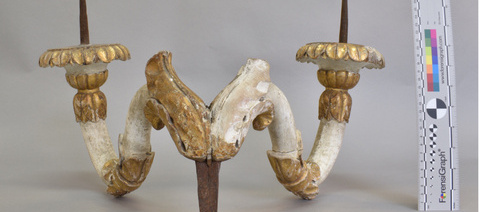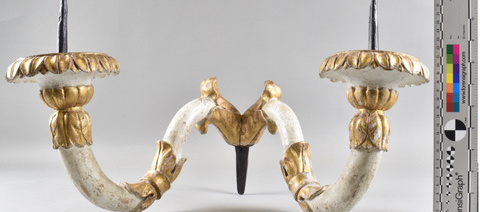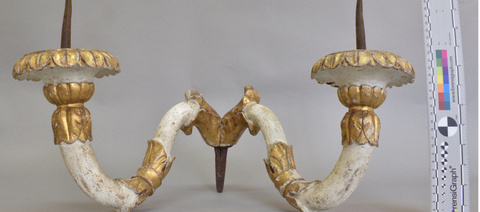Eighteenth-century Gilded Sconce
One of the first composite objects I treated during my Masters at Durham University, this wooden twin-branched parcel gilt wall sconce is supported by an iron core, terminating in the two prickets and a central wall bracket. The sconce required cleaning, corrosion removal, moulding, casting and re-gilding to enable it's redisplay within Kiplin Hall & Gardens.
What was the goal the project set out to achieve?
Prior to conservation the sconce was covered with significant surface dirt, including deposits of bird droppings and wax. The iron elements featured flash rusting. Additionally, there was cracking and areas of significant loss to the wooden structure and decorative scrolling acanthus leaves, alongside wear and loss to the gilding and white gesso paint, revealing the wooden surface below.
The primary aim for this project was restoration of the areas of loss to the wood and gilding to enable the sconce to be displayed once again in Kiplin Hall. The curators requested a minimally interventive approach, so the sconce was cleaned sufficiently for stabilisation and only the most visually distracting areas of loss were restored. The sconce is also part of a set of three, one of which had been conserved a year prior. This previous treatment was therefore used as a guide to ensure the three sconces were aesthetically cohesive and in a similar state of restoration following treatment.
What did I do?
Cleaning was undertaken to remove the surface dirt, wax residues and bird droppings. The sconce was vacuumed to remove loose dirt and then cotton swabs moistened with artificial saliva solution were used to clean the painted and gilded areas. The wax residues were mechanically removed using a wooden cocktail stick before white spirit was then used to remove remaining wax residues and the bird dropping deposits.
The iron surfaces were cleaned using fine steel wool and 3-in-1 oil to remove corrosion products. Three coats of a 2.5% tannic acid in deionised water, ethanol and phosphoric acid solution were then applied as a rust convertor. Tannic acid was chosen as it was used during conservation of the matching sconce and results in a distinctive blue-black finish, so its use here ensured visual cohesion of the sconces. Renaissance microcrystalline wax was the applied to protect the iron surfaces against future corrosion.
Before filling, in-painting, and re-gilding any areas of loss, an isolating layer of 50% Plexetol 500 in a 4:1 water:ethanol mixture was painted on the areas to be filled, painted or gilded to aid treatment reversibility. Areas of loss to the wood were cast in Milliput by taking Siligum moulds from the matching sconces. The casts were adhered to the sconce using 40% Paraloid B72 in acetone. Gaps between the casts and the object and the structural cracks to the wood were filled using Modostuc and Flügger.
A traditional water gilding method was used for gilding the casts and areas of loss. The newly gilded areas were then distressed using steel wool and toned with acrylic paints to match the age and wear of the rest of the sconce. The significant areas of wear and loss to the white gesso were filled using Modostuc and in-painted with acrylic paints to match the surrounding surface.
What was the outcome?
The conservation treatment stabilised the sconce via cleaning and corrosion removal and helped prevent future deterioration by the application of the Renaissance wax. The restoration of the large, visually distracting areas of loss to the wood and gilding means the sconce is now suitable for display once again within Kiplin Hall.
What did I learn?
The sconce was one of the first composite objects I treated during my time at Durham University. It taught me about the challenges of conserving objects containing multiple materials which have numerous and sometimes conflicting treatment requirements. The restoration process allowed me to practice and improve my moulding and casting skills which was a really valuable experience, while also learning new skills, such as gilding.

